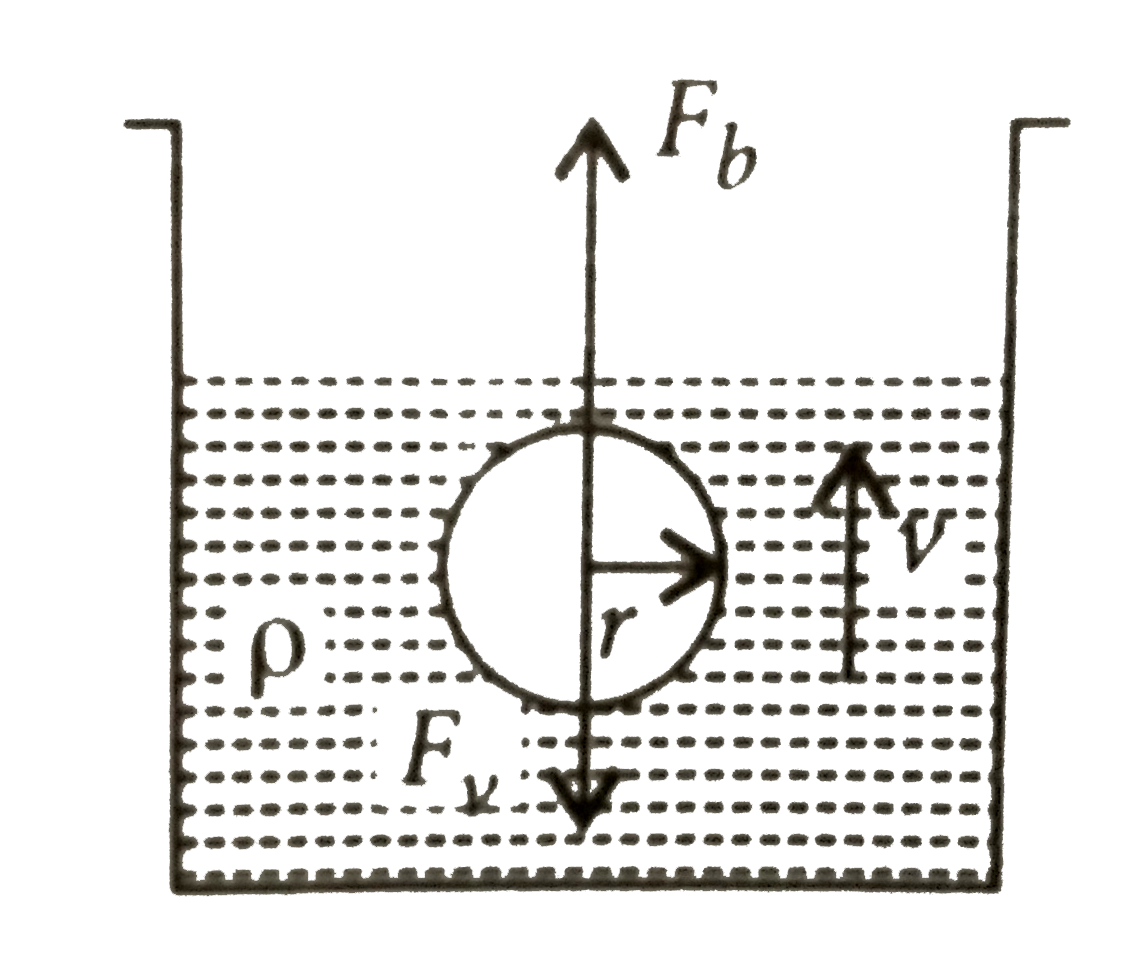A gas bubble of 2 cm diameter rises through a liquid 1.75gmcm−3 with a fixed speed of 0.35cms−1.Naglect the density of the gas. The cofficient of viscosity of the liquid is
870 poise
1120 poise
982 poise
1089 poise
The correct Answer is:D
As gas bubble is moving upward with constant spped so Buoyant force=Viscous drag force
⇒Fb=Fv⇒(43πr3)ρg=6πηrv
⇒η=29r2ρgv
Here, r=1 cm, ρ=1.75gcm−3
g=980cms−2
v=0.35cms−1,η=?
∴η=29×12×1.75×9800.35=1088.88≈1089 poise

Topper's Solved these Questions
- BOOK - NCERT FINGERTIPSCHAPTER - MECHANICAL PROPERTIES OF FLUIDSEXERCISE - Reynolds Number4videos
MECHANICAL PROPERTIES OF FLUIDS
- BOOK - NCERT FINGERTIPSCHAPTER - MECHANICAL PROPERTIES OF FLUIDSEXERCISE - Surface Tension31videos
MECHANICAL PROPERTIES OF FLUIDS
- BOOK - NCERT FINGERTIPSCHAPTER - MECHANICAL PROPERTIES OF FLUIDSEXERCISE - Bernoulli'S Principle15videos
MECHANICAL PROPERTIES OF FLUIDS
- BOOK - NCERT FINGERTIPSCHAPTER - LAWS OF MOTIONEXERCISE - Assertion And Reason15videos
LAWS OF MOTION
- BOOK - NCERT FINGERTIPSCHAPTER - MECHANICAL PROPERTIES OF SOLIDSEXERCISE - Assertion And Reason15videos
MECHANICAL PROPERTIES OF SOLIDS
Similar Questions
An air bubble of diameter 2mm rises steadily through a solution of density 1750kgm−3 at the rate of 0.35cms−1 .Calculate the coefficient of viscosity of the solution (in Pascal×Sec).The density of air is negligible. (g=9.8ms2)
View SolutionA gas buble of diameter 2 cm rises steadily at the rate of 2.5mms−1 through a solution of density 2.25 g cm−3. Calculate the cofficient of viscosity of the lquid. Neglect the density of the gas.
View Solution
Knowledge Check
- Question 1 - Select One
An air bubble of 1 cm radius is rising at a steady rate of 2.00ms−1 through a liquid of density 1.5gcm−3. Neglect density of air. If g=1000cms−2, then the coeffieciet of viscosity of the liquid is
A0.166×103 PoiseB1.66×10−3 poiseC166×103 poiseD16.6×103 poise - Question 2 - Select One
A lead sphere of 1.0mm diameter and relative density 11.20 attains a terminal velocity of 0.7cms−1 in a liquid of relative density 1.26.
Determine the coefficient of dynamic viscosity of the liquid.A0.45N/m2B0.85N/m2C0.56N/m2D0.77N/m2
An air bubble of 1cm radius is rising at a steady rate of 0.5cms−1 through a liquid of density 0.81gcm−3. Calculate the coefficient of viscosity of the liquid. Neglect the density of air. ( Take g=10m/s2)
View SolutionA liquid Flows through a pipe 2.0 mm radius and 20 cm length under a pressure 103 dyne cm−2. Determine the rate of flow and the speed of the liquid coming out of the tube. The coefficient of viscosity of the liquid is 1.25 centipoise.
View SolutionA liquid flows through a pipe of 1.0 mm radius and 10cm length under a pressure 104 dyne cm−2. Calculate the rate of flow and the speed of the liquid coming out of the tube. The coefficient of viscosity of the liquid is 1.25 centipoise.
View SolutionIf a tangential force of 1dyne cm−2 of the surface is required to maintain a relative velocity of 1cms−1 between two layers of a liquid 1 cm apart, then the coefficient of viscosity of the liquid is said to be___.
View SolutionA liquid flows through a pipe 1.0 mm radius and 20 cm length under a pressure of 104dyne/cm2 Calculate (i) the rate of flow and (ii) the speed of the liquid coming out of the tube. The coefficient of viscosity of liquid is 1.23×02dynecm−2s.
View SolutionAn air bubble of diameter 2 cm is allowed to rise through a long cylindrical columu of viscous liquid and travels at the rate of 0.21 cms−1 If the density of the liquid is 1.47gcm−3 find the cofficient of vicosity .Given g=9.8ms−2 Density of air is to be neglecteed .
View Solution

